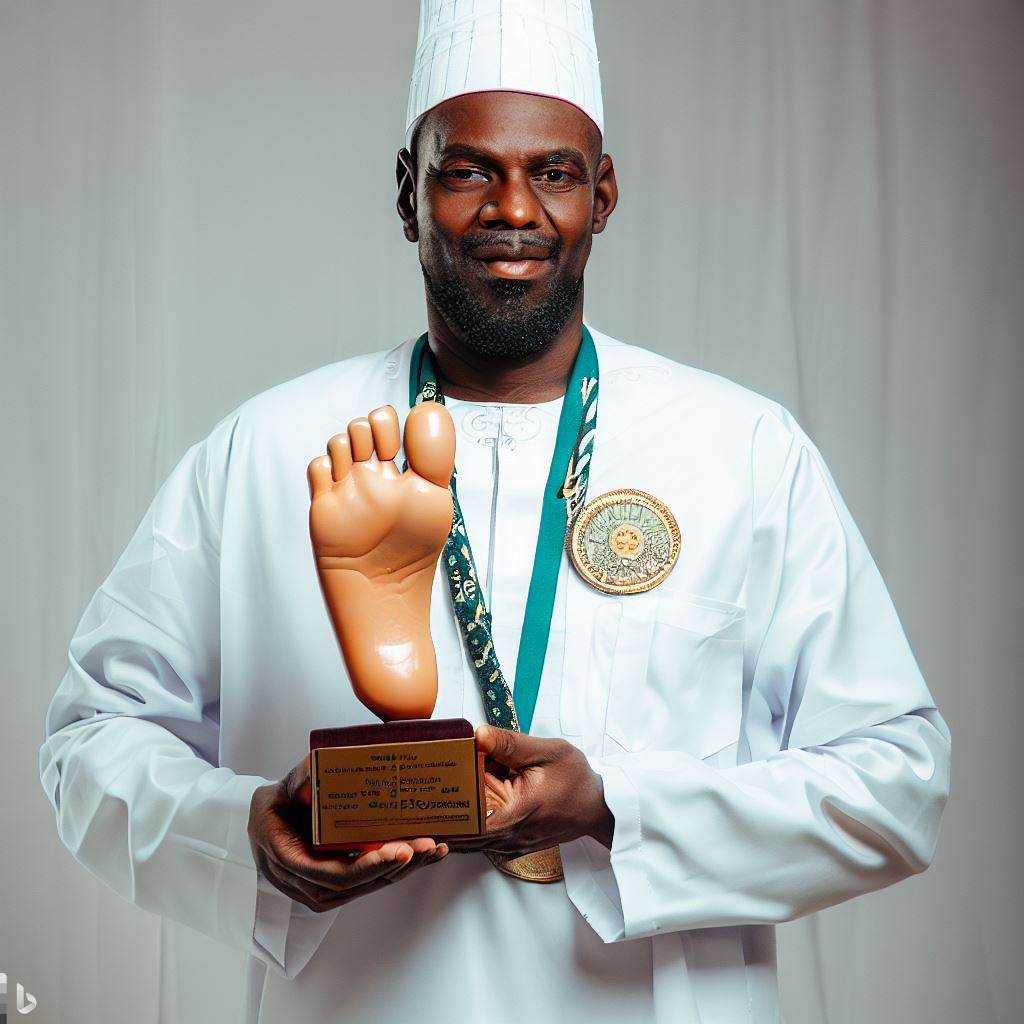Introduction
Do you know that there are significant differences between podiatry practices in Nigeria and abroad?
Background information on podiatry
Podiatry is a medical specialty that focuses on the diagnosis and treatment of foot and ankle disorders.
The purpose of the blog post
This blog section aims to compare and contrast the practice of podiatry in Nigeria with podiatry practices abroad.
Podiatry plays a crucial role in maintaining foot health, preventing diseases, and managing foot-related conditions.
In Nigeria, podiatry is an emerging field that is gaining recognition for its contribution to overall healthcare.
However, when comparing it to podiatry practices abroad, significant differences become apparent.
One major difference lies in the access to advanced technology and treatment options.
In countries like the United States and the United Kingdom, podiatrists have access to state-of-the-art equipment, cutting-edge techniques, and a wide range of treatment options.
This enables them to provide comprehensive and specialized care to their patients.
Another difference is the level of specialization and expertise. In Nigeria, podiatrists often have a broader scope of practice, handling a variety of foot conditions.
Conversely, in countries like Australia and Canada, podiatrists are highly specialized and focus on specific areas or conditions.
Additionally, the availability of research and ongoing education opportunities is more extensive abroad.
In these countries, podiatrists access abundant scientific literature, attend conferences, and join training programs, staying updated on field advancements.
The practice of podiatry in Nigeria differs significantly from practices abroad in terms of technological advancements, specialization, and research opportunities.
Recognizing these differences can help shed light on areas for improvement and potential collaborations to enhance podiatric care in Nigeria.
Overview of Podiatry in Nigeria
A. Definition and Importance of Podiatry
Podiatry is a specialized branch of medicine that focuses on the diagnosis, treatment, and prevention of foot and ankle disorders, from simple to complex conditions.
It plays a crucial role in maintaining overall foot health, which directly impacts a person’s mobility and quality of life
B. Brief History and Development in Nigeria
The development of podiatry in Nigeria can be traced back to the late 20th century.
Initially, it was a relatively unknown field, and few podiatrists were practicing in the country.
However, with growing awareness of foot-related problems and the need for specialized care, the demand for podiatrists has increased over the years.
C. Challenges Faced by Podiatrists in the Country
Despite the progress made in the field of podiatry in Nigeria, there are several challenges that podiatrists face:
- Limited Recognition: Podiatry is still not widely recognized as a specialized medical field in Nigeria.
This lack of recognition affects the professional status of podiatrists and hinders their ability to provide comprehensive foot care. - Inadequate Training Facilities: Nigeria lacks sufficient training facilities and institutions that specialize in podiatry education.
This scarcity hampers the development and training of aspiring podiatrists, limiting the number of professionals in the field. - Lack of Awareness: Many people in Nigeria are still unaware of the importance of foot care and the role of podiatrists in maintaining healthy feet.
This lack of awareness leads to delays in seeking treatment and results in exacerbated foot problems. - Inadequate Government Support: Podiatry in Nigeria does not receive adequate government support in terms of funding and policies.
This lack of support makes it challenging for podiatrists to expand their practice, conduct research, and deliver quality care to patients. - Insufficient Infrastructure: The absence of adequate podiatry infrastructure, such as specialized clinics and well-equipped foot care centers, makes it difficult for podiatrists to provide optimal care.
This lack of infrastructure also contributes to the overall underdevelopment of the field. - Financial Constraints: Access to podiatric care in Nigeria can be costly for patients, as health insurance coverage for podiatry services is limited.
This financial constraint prevents many individuals from seeking timely treatment, leading to prolonged foot-related issues. - Lack of Collaboration: There is a need for improved collaboration between podiatrists and other healthcare professionals in Nigeria.
A multidisciplinary approach would enhance patient care and ensure holistic treatment for individuals with complex foot conditions.
Podiatry in Nigeria is still in its nascent stage despite its growing importance.
Overcoming the challenges faced by podiatrists is crucial to enhance awareness, improve training facilities, increase government support, and establish specialized infrastructure.
By addressing these issues, Nigeria can provide better foot care services and improve the overall quality of life for its citizens.
Read: How Podiatrists are Addressing Diabetes in Nigeria
Comparison of podiatry education and training in Nigeria and abroad
A. Accreditation process and standards in Nigeria
- The accreditation process for podiatry education in Nigeria is overseen by the Medical and Dental Council of Nigeria (MDCN).
- MDCN ensures that podiatry programs meet the required standards for curriculum, facilities, and faculty qualifications.
- Podiatry programs in Nigeria must undergo a rigorous evaluation process to obtain accreditation.
- Accreditation ensures that graduates receive a high-quality education and are prepared for professional practice.
B. Comparison of curriculum and coursework
- In Nigeria, the podiatry curriculum includes basic medical sciences, podiatric theory, and clinical skills.
- Abroad, podiatry programs have a more comprehensive curriculum, including advanced medical sciences and specialized courses.
- Foreign programs also focus on research, evidence-based practice, and the latest advancements in podiatry.
- The coursework in foreign programs is designed to provide a broader knowledge base and enhance critical thinking skills.
C. Inclusion of practical experience and clinical rotations
- Practical experience and clinical rotations are essential components of podiatry education in both Nigeria and abroad.
- In Nigeria, students have clinical rotations in hospitals, where they gain hands-on experience in diagnosing and treating foot and ankle conditions.
- Abroad, students have the opportunity to work in various healthcare settings, including private clinics and specialized foot care centers.
- Foreign programs prioritize practical experience to ensure graduates are competent and confident podiatrists.
D. Differences in the duration of education and training
- In Nigeria, podiatry education and training typically take five years, including pre-clinical and clinical phases.
- Abroad, the duration of podiatry programs varies, but most countries require a minimum of three years of undergraduate education.
- Some countries offer postgraduate programs, leading to advanced degrees in podiatry, which require additional years of study.
- The longer duration of education and training in foreign programs allows for a more in-depth exploration of podiatric concepts and practices.
The study of podiatry in Nigeria and abroad exhibits both similarities and differences.
While both Nigerian and foreign programs aim to produce competent podiatrists, there are variations in accreditation processes, curriculum, practical experience, and duration of education.
It is essential to recognize these differences and continually improve podiatry education in Nigeria to align with international standards and enhance the quality of podiatric care in the country.
In this section, we will discuss the scope of practice and areas of specialization in podiatry, both in Nigeria and abroad.
Read: Global Practices vs. Nigerian Practices in Podiatry
Transform Your Career in Nigeria
Discover unmatched expertise with our personalized Career Consulting service. Navigate Nigeria’s job market with a strategy tailored just for you.
Get StartedScope of practice and areas of specialization in podiatry
A. Services provided by podiatrists in Nigeria
- Podiatrists in Nigeria provide a wide range of services for foot and ankle conditions.
- They diagnose and treat foot and ankle ailments such as fractures, sprains, and infections.
- They prescribe medications, perform surgeries, and provide wound care for diabetic foot ulcer
- Podiatrists also provide orthotics and custom-made footwear to address various foot deformities.
B. Areas of specialization available in Nigeria
- In Nigeria, podiatrists can specialize in areas such as sports podiatry, diabetic foot care, and pediatric podiatry.
- Specialization in biomechanics and gait analysis is also available for podiatrists.
- These specializations allow podiatrists to focus on specific conditions and provide specialized treatments.
C. Comparison with the scope of practice in other countries
- The scope of practice in podiatry may vary between different countries.
- In some countries, podiatrists have full prescribing rights and can perform advanced surgical procedures.
- Other countries may limit podiatrists’ practice to conservative treatments and minor surgical procedures.
- It is important for podiatrists to be aware of the scope of practice in different countries if they plan to practice internationally.
D. Opportunities for further specialization in podiatry abroad
- Podiatrists who wish to further specialize in their field have numerous opportunities abroad.
- Many countries offer advanced training programs and fellowships in specialized areas of podiatry.
- Podiatrists can pursue specialization in areas such as foot and ankle surgery, sports medicine, and wound care.
- Furthermore, some countries have highly specialized clinics and research centers that provide unique learning opportunities.
Podiatry in Nigeria offers a wide range of services and areas of specialization. Podiatrists play a crucial role in diagnosing, treating, and preventing foot and ankle conditions.
While the scope of practice may differ between countries, there are opportunities for Nigerian podiatrists to further specialize and gain advanced knowledge abroad.
Read: Unfolding the Vast World of Healthcare Professions in Nigeria

Equipment, technology, and resources available for podiatry
A. Availability of medical equipment and facilities in Nigeria
- Limited availability and accessibility to modern podiatry equipment and facilities in Nigeria.
- Lack of investment and infrastructure development in the healthcare sector contributes to this issue.
- Majority of podiatrists rely on basic tools and outdated equipment for diagnosis and treatment.
- Inadequate resources hinder the effective practice of podiatry, leading to suboptimal patient outcomes.
B. Advancements in podiatry technology and resources abroad
- Countries with well-developed healthcare systems have access to state-of-the-art podiatry equipment.
- Advanced technologies such as laser therapy, robotic-assisted surgeries, and 3D printing revolutionize podiatric care.
- Abroad, podiatrists have access to specialized foot scanners, gait analysis systems, and advanced imaging devices.
- Advanced resources enhance accuracy, precision, and overall efficiency in diagnosing and treating foot conditions.
C. Impact of technological advancements on the field
- Technological advancements improve diagnosis accuracy, enabling early detection of foot problems.
- Advanced equipment and resources enhance the success rates of podiatric surgeries.
- Rehabilitation and recovery times are reduced due to innovative technologies used in the field.
- Technology-driven podiatry promotes better patient outcomes, improved quality of life, and higher patient satisfaction.
In Nigeria:
- Limited availability of medical equipment and facilities severely hampers the quality of podiatry care.
- Outdated equipment and lack of resources contribute to delayed diagnosis and ineffective treatments.
- Foot conditions that require advanced intervention may go untreated or result in substandard care.
Abroad:
- Podiatrists benefit from cutting-edge technology and resources that enhance diagnostic and treatment capabilities.
- Technological advancements have transformed podiatry into a highly efficient and effective field.
- The use of advanced equipment ensures accurate diagnoses, precise surgeries, and improved patient outcomes.
The availability of resources in podiatry ultimately affects the quality of care provided to patients.
While abroad, podiatrists have access to the latest tools and technology that empower them to offer optimal treatment options.
In contrast, Nigerian podiatrists face numerous challenges due to limited resources and outdated equipment.
This discrepancy highlights the need for investment in the Nigerian healthcare system to bridge the gap and improve podiatric care.
To improve the availability of medical equipment and facilities in Nigeria:
- Increased government funding is necessary to upgrade existing healthcare infrastructure.
- Public-private partnerships can be formed to attract investments and improve resource availability.
- International collaborations and exchange programs can facilitate the transfer of technology and knowledge.
The availability of medical equipment, technology, and resources plays a crucial role in the practice of podiatry.
While advancements abroad have revolutionized the field, Nigeria faces challenges due to limited resources and outdated equipment
Addressing these issues is essential to enhance the quality of podiatric care in Nigeria and ensure that patients receive the best possible treatment options and outcomes.
Read: Tips for Aspiring Podiatrists in Nigeria’s Healthcare Scene
Job opportunities and career prospects in podiatry
A. Employment opportunities for podiatrists in Nigeria
- Podiatry is a growing field in Nigeria, with increasing demand for specialized foot care.
- Hospitals, clinics, and private practices in Nigeria are seeking podiatrists to meet the growing needs.
- Public health programs also hire podiatrists to address foot-related issues in communities.
- Podiatrists in Nigeria have the opportunity to work with multidisciplinary teams, including orthopedic surgeons and physiotherapists.
- Job opportunities exist in urban as well as rural areas, bringing foot care to underserved communities.
B. Comparison of salary and income potential in Nigeria and abroad
- The salary range for podiatrists in Nigeria varies depending on experience, location, and type of practice.
- Podiatrists in Nigeria generally earn less than their counterparts abroad due to economic factors.
- In developed countries like the United States, Canada, and the United Kingdom, podiatrists have higher income potential.
- The earning potential abroad is influenced by factors like demand, competition, and healthcare system sophistication.
- Specializing in specific areas, such as sports podiatry or diabetic foot care, can also enhance income potential.
C. Potential for career advancement and professional growth
- Podiatrists in Nigeria have opportunities to advance their careers through postgraduate studies and specialization.
- Continuing education programs and conferences offer avenues for professional growth and knowledge enhancement.
- With experience and expertise, podiatrists can establish their private practices, expanding their scope of services.
- Collaboration with international podiatry associations can facilitate knowledge sharing and career advancement.
- Podiatrists can also contribute to research, publications, and training programs, adding to their professional growth.
D. Factors influencing practicing podiatry in Nigeria versus abroad
- In Nigeria, limited recognition and awareness of podiatry as a specialized medical field can be a challenge.
- Access to advanced technology, specialized equipment, and resources may be limited in Nigeria compared to abroad.
- The economic climate and healthcare infrastructure contribute to disparities in practicing podiatry in Nigeria.
- Migration to foreign countries for better opportunities is a factor that affects podiatry in Nigeria.
- Government policies, healthcare funding, and insurance systems also influence podiatric practice in both settings.
Podiatry in Nigeria offers employment opportunities, though with lower income potential compared to practicing abroad.
However, there are prospects for career advancement and professional growth through specialization and collaborations.
Factors such as limited recognition, access to resources, economic climate, and migration influence the practice of podiatry in Nigeria as well as abroad.
Despite these challenges, the field of podiatry in Nigeria continues to evolve and contribute to the healthcare system.
Read: Occupational Therapy Schools: Where to Study in Nigeria
Conclusion
A. Summary of key points discussed
In this comparative study, we examined the field of podiatry in Nigeria versus abroad.
We looked at the education and training requirements, as well as the scope of practice and available resources.
We also discussed the challenges and opportunities faced by podiatrists in both settings.
B. Personal opinion or recommendations
Based on our research, it is clear that there are significant differences between podiatry in Nigeria and abroad.
While abroad, podiatry is a well-established and recognized field with advanced resources and opportunities for specialization, in Nigeria, it is still emerging and faces many challenges.
To improve podiatry in Nigeria, it is crucial to invest in education and training programs.
Healthcare authorities should develop comprehensive regulations and accreditation systems to ensure high-quality care.
Additionally, collaboration and knowledge sharing with international institutions can help bridge the gap between Nigerian podiatry and international standards.
C. Closing remarks
This study highlights the disparities between podiatry in Nigeria and abroad.
It emphasizes the need for extensive development and investment in the field within Nigeria to provide optimal foot care services for the population.
With proper support and dedication, Nigeria can gradually close the gap and provide a higher standard of podiatric care for its citizens.




